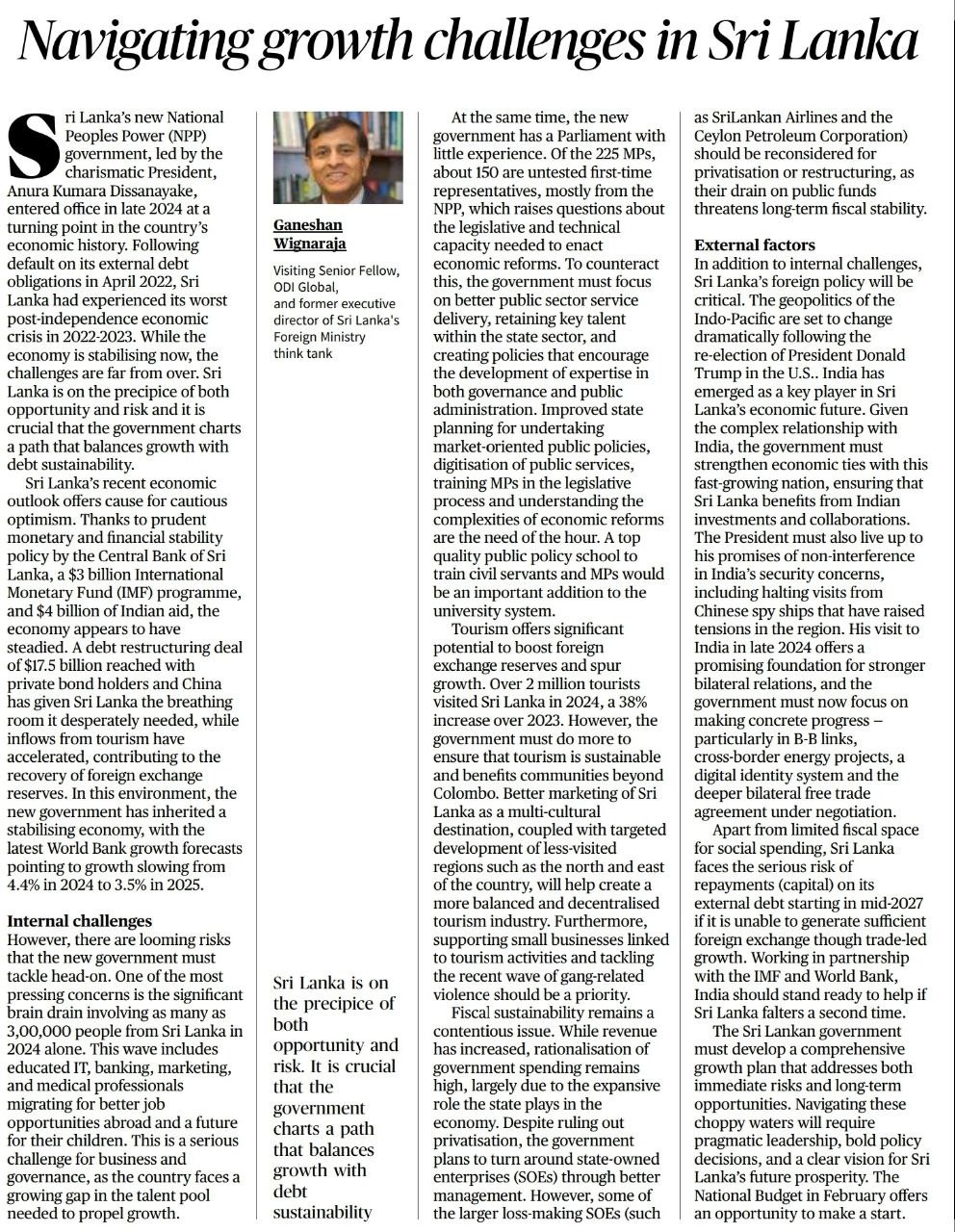1. Sri Lanka’s Economic Recovery: Challenges and Opportunities
Introduction
Sri Lanka’s economy has faced severe challenges in recent years, including its worst economic crisis (2022–2023) and a sovereign default. The new National Peoples Power (NPP) government, led by Anura Kumara Dissanayake, took office in late 2024, inheriting a fragile but stabilizing economy. The government must now balance growth with debt sustainability while addressing internal and external challenges.
- Economic Situation and Stabilization Efforts
- Sri Lanka faced an economic crisis due to external debt default in 2022.
- The country received financial support from the IMF ($3 billion) and India ($4 billion).
- Debt restructuring, including a $17.5 billion deal with private bondholders and financial assistance from China, has helped stabilize the economy.
- Tourism recovery and increased foreign exchange inflows have further strengthened stability.
- GDP growth is expected to slow from 4.4% (2024) to 3.5% (2025), as per World Bank forecasts.
- Internal Challenges
- Brain Drain: Over 3 million skilled professionals (IT, banking, medical) left Sri Lanka in 2024, creating a labor shortage.
- Parliamentary Experience: 150 of 225 MPs are first-time members from the NPP, raising concerns about their legislative expertise.
- Public Sector Efficiency: Reforms are needed to retain talent, improve service delivery, and reduce inefficiencies.
- State-Owned Enterprises (SOEs): Loss-making SOEs like Sri Lankan Airlines and Ceylon Petroleum Corporation require privatization or restructuring.
- External Factors and Geopolitics
- India’s Role: Strengthening relations with India is crucial for economic stability, particularly in trade, investment, and technology collaboration.
- Regional Geopolitics: The return of Donald Trump as U.S. President (2024) and Indo-Pacific tensions may impact Sri Lanka’s foreign policy and trade.
- China’s Influence: Concerns about China’s control over strategic assets and its financial assistance must be carefully managed.
- Key Sectors for Economic Growth
- Tourism: Over 2 million tourists visited in 2024 (38% increase). Sustainable tourism policies should ensure balanced regional development.
- Small Business Development: Support for businesses linked to tourism and efforts to tackle gang-related violence can boost economic resilience.
- Fiscal Stability: Rationalizing government spending and restructuring debt repayment plans will be critical to avoiding another financial crisis.
Conclusion
Sri Lanka stands at a crossroads, with both risks and opportunities ahead. The NPP government must implement structural reforms, strengthen governance, and attract investments while ensuring debt sustainability. Pragmatic leadership, sound policymaking, and strong international partnerships will be key to long-term economic stability.
Bottom of FormMains Practice Question |
Q. Discuss the key challenges and opportunities in Sri Lanka’s economic recovery post-2024. How can the government ensure sustainable growth while managing debt and external influences? |
2. Regulating Homeopathic Alcoholic Tinctures: Legal and Public Health Challenges in India
Introduction
The Supreme Court’s ruling in Bhagwati Medical Hall vs Central Drugs Standard Control Organization has reignited debates over the regulation of homeopathic alcoholic tinctures. These tinctures, which contain up to 12% alcohol, have been misused as cheap substitutes for liquor, especially in states with prohibition. While the Union government has attempted to curb their misuse through regulations, legal ambiguities and industry lobbying have hindered enforcement, posing a significant public health risk.
- Regulatory and Legal Complexities
- Constitutional and Legislative Framework:
- Alcohol regulation is a State subject (Entry 51, State List), but medicinal alcohol taxation was previously governed by the Union under the Medicinal and Toilet Preparations (Excise Duties) Act, 1955.
- The introduction of GST in 2017 removed certain taxation powers, creating legal ambiguities.
- The Drugs and Cosmetics Act, 1940, allows homeopathic tinctures to contain up to 12% alcohol, making regulation complex.
- Judicial and Administrative Challenges:
- States like Gujarat and Bihar (with prohibition laws) have struggled to regulate these tinctures, leading to misuse.
- The Union government introduced Rule 106B in the Drugs and Cosmetics Rules, 1945, restricting sales to hospitals, but industry opposition delayed enforcement.
- Multiple court cases prolonged regulatory action, with the Supreme Court only recently upholding the government’s authority.
- Public Health Risks
- Misuse as a Substitute for Alcohol:
- In states with prohibition, homeopathic tinctures are consumed as liquor alternatives.
- High alcohol content (up to 12%) makes them attractive to consumers looking for cheap substitutes.
- Reports indicate deaths and health complications due to excessive consumption.
- Industry Influence and Resistance:
- The homeopathy industry argues that restricting sales affects trade and violates their commercial rights.
- Legal challenges from the industry have delayed regulations, allowing misuse to continue.
- Lack of awareness and regulatory enforcement worsens public health risks.
- Way Forward: Strengthening Regulation and Enforcement
- Regulatory Clarity and Coordination:
- The government must clearly define regulatory responsibilities between Union and State authorities.
- Revising the Drugs and Cosmetics Act to impose stricter controls on alcohol-based medicinal products.
- Stronger Enforcement Mechanisms:
- Implementing stringent sales monitoring and penalties for misuse.
- Strengthening judicial mechanisms to prevent prolonged litigation from delaying regulations.
- Public Awareness and Responsible Use:
- Campaigns to educate consumers on the risks of using homeopathic tinctures as alcoholic substitutes.
- Encouraging the homeopathy industry to promote genuine medicinal use while preventing abuse.
Conclusion
The increasing threat to civil aviation safety in conflict zones demands immediate attention from global regulatory bodies and governments. Strengthening operational protocols, fostering international cooperation, and investing in pilot training and modern technology are essential to safeguard civilian lives.
Mains Practice Question |
Q. The misuse of homeopathic alcoholic tinctures highlights gaps in India’s regulatory and public health systems. While the Supreme Court has upheld the Union’s authority to regulate these products, implementation challenges persist. A balanced approach is needed to protect public health, ensure responsible industry practices, and close legal loopholes that enable misuse. |
3. Union Budget and India's Climate Action: Policy Imperatives for a Sustainable Future
Introduction
The Union Budget plays a crucial role in shaping India’s climate response, especially as the nation faces increasing climate-induced disasters and rising global pressure to meet its Net-Zero targets. With only five years left to achieve India’s first interim Net-Zero milestone, the Budget must take decisive steps in accelerating clean energy adoption, boosting green finance, and integrating climate concerns into economic planning.
- Need for a Strong Climate Budget
- India’s total renewable energy installed capacity is 203.18 GW, far below the 500 GW target by 2030.
- Previous Budgets have supported climate action through schemes like:
- PM Surya Ghar Muft Bijli Yojana (solar power for households).
- Support for electric vehicle infrastructure and offshore wind energy.
- Increased allocations for the National Green Hydrogen Mission.
- However, challenges in policy implementation and financing remain.
- Key Policy Measures for Climate Action
- Renewable Energy and Energy Transition
- The PM Surya Ghar Muft Bijli Yojana needs reforms to address slow implementation and high upfront costs.
- Fiscal solutions such as the Renewable Energy Service Company (RESCO) model can help reduce costs for lower-income households.
- Expansion of production-linked incentives (PLI) for solar manufacturing to reduce dependence on imports.
- EU’s Carbon Border Adjustment Mechanism (CBAM) and India’s Response
- CBAM, effective from January 2026, will tax carbon-intensive imports into the EU, affecting India’s exports.
- India’s total exports impacted by CBAM could reach $8.22 billion annually, increasing carbon levies by 20%–50%.
- The Budget should introduce carbon pricing policies and create a ‘Climate Action Fund’ to assist industries in green transitions.
- Circular Economy and Climate Resilience
- Incentives for businesses investing in recycling and refurbishment technologies to promote a circular economy.
- Sovereign green bonds should be expanded to finance climate-resilient infrastructure.
- Tax incentives for insurance companies offering climate-linked policies.
- The Role of Green Finance
- Green finance definitions need standardization to build investor confidence.
- The Budget should allocate funds for:
- Climate resilience programs.
- Infrastructure for early warning systems and disaster mitigation.
- Financial support for green MSMEs.
- Differential tax treatment for taxonomy-aligned investments can accelerate green financing.
Conclusion
Climate action is no longer an isolated policy issue but a core economic concern tied to global trade, investment, and sustainability. The upcoming Budget must integrate strong climate policies, renewable energy investments, and financial support mechanisms to align India’s economic growth with its Net-Zero commitments. A strategic budget can position India as a leader in global green finance and sustainable economic growth.
Mains Practice Question |
Q. The Union Budget plays a crucial role in shaping India’s climate policies. Discuss the key challenges and opportunities in integrating climate commitments into fiscal policy. Suggest measures to enhance India’s green economy through budgetary interventions. |




